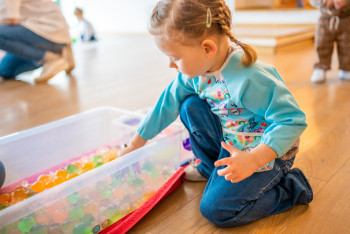Sensory water beads: What parents and caregivers should know
Posted on June 20, 2023 by the Canadian Paediatric Society | Permalink
Topic(s): Public education
By Dr. Daniel Rosenfield and Dr. Suzanne Beno
Water beads are small, colourful absorbent beads that can be used for various purposes, such as home decoration, plant hydration, and sensory play for kids. However, these seemingly harmless beads can pose a significant danger if ingested.
Water beads are made of a superabsorbent polymer that can expand up to 1,500 times their original size when exposed to water. When swallowed, these beads can quickly expand and cause numerous problems leading to potentially severe complications, or even death.
Dangers of young children swallowing water beads
- Choking: Water beads are small and can easily be swallowed. If they get lodged in the throat, they can cause choking, which can be life-threatening if not treated immediately.
- Intestinal blockages: Once ingested, water beads can expand in the intestines and cause blockages. This can lead to severe abdominal pain, vomiting, and dehydration, and in extreme cases, can require surgery to remove the beads.
- Toxicity: Some water beads are made with harmful chemicals that can be toxic if ingested. These chemicals can cause a range of health issues, including vomiting, diarrhea, and organ damage.
- Suffocation: If water beads are inhaled, they can become lodged in the airways and cause suffocation. This is particularly dangerous for young children who may not be able to communicate the problem.
- Other: Water beads can be placed in the nostrils, ear canals or genitals. Blockages of these pathways can also cause significant morbidity if not addressed in a timely manner.
Prevention
The best way to prevent kids from swallowing water beads is to not have them in the house. Otherwise, parents should keep them stored out of reach and in a sealed container where young children cannot access them. Parents and caregivers can also take the following steps:
- Supervise: Young children should always be supervised by an attentive caregiver when playing with water beads.
- Educate: Parents and caregivers should educate their children on the dangers of swallowing water beads and the importance of not putting them in their mouths. This is particularly important when older children are playing with younger siblings.
- Provide alternatives: There are many safer sensory play alternatives that do not involve water beads, such as sand, playdough, rice, dried beans, pom-poms or foam blocks.
What to do if a child swallows water beads
A parent or caregiver should seek medical attention immediately if they suspect that a child has swallowed water beads.
The symptoms of a water bead ingestion can resemble those of other digestive issues, so it is essential to get a proper diagnosis. Parents should not induce vomiting, as this can worsen the situation and cause further complications.
While water beads can be a fun and engaging sensory play activity for young children, they can also pose a significant danger if ingested. By taking the precautions mentioned above, parents and caregivers can ensure that children can safely enjoy sensory play activities.
For all things child safety and injury prevention, visit Caring for Kids.
Dr. Suzanne Beno and Dr. Daniel Rosenfield are members of the Canadian Paediatric Society’s Injury Prevention Committee and Emergency Department paediatricians at The Hospital for Sick Children in Toronto.
Copyright
The Canadian Paediatric Society holds copyright on all information we publish on this blog. For complete details, read our Copyright Policy.
Disclaimer
The information on this blog should not be used as a substitute for medical care and advice. The views of blog writers do not necessarily represent the views of the Canadian Paediatric Society.
Last updated: Mar 21, 2024

